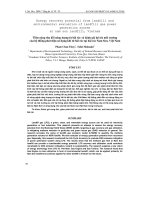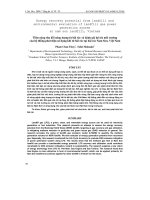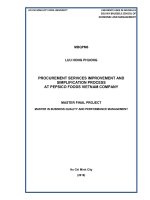Final Project Report Redesign Ceilling Fan And Evaluate Effectiveness.pdf
Bạn đang xem bản rút gọn của tài liệu. Xem và tải ngay bản đầy đủ của tài liệu tại đây (3.94 MB, 26 trang )
<span class="text_page_counter">Trang 1</span><div class="page_container" data-page="1">
<b>SCHOOL OF MECHANICAL ENGINEERING </b>
<b>FINAL PROJECT REPORT </b>
<b>REDESIGN CEILLING FAN AND EVALUATE EFFECTIVENESS </b>
<b>Course </b> : Lifelong Development for Engineers
<b>Instructor </b> : Assoc. Prof. PhD. Nguyen Thi Hong Minh
<i><b>Hanoi, June 2021 </b></i>
</div><span class="text_page_counter">Trang 2</span><div class="page_container" data-page="2">Students: Do Duc Thang - 20163824; Vu Anh Quang - 20163330; Nguyen Van Tu - 20164585 <b>1 </b>
<b>CONTENTS </b>
<b>2.2. General structure analysis of a ceilling fan ... 10</b>
<b>CHAPTER 3. ENVIRONMETAL IMPACTS OF PRODUCTS ... 12</b>
<b>3.1. Environmental impact calculation tool ... 12</b>
<b>3.2. Evaluate the effectiveness of changing material ... 14</b>
</div><span class="text_page_counter">Trang 3</span><div class="page_container" data-page="3"><b>ABSTRACT </b>
Along with the strong development of science and technology in the 4th industrial age, environmental protection emerges as a vital factor for mankind. For centuries, humans have ravaged nature, destroying the environment in exchange for development. This has led to serious consequences that we gradually see and feel today.
As future engineers, we need to be aware of and learn the methods of research, evaluation and development of products to ensure environmental friendliness. In this project, we focus on using research methods, evaluating the re-engineering and improving the environmental impacts of ceiling fans in phases such as production, heavy consumption and recycling. Through this project, we will equip ourselves with knowledge about environmental protection and have a method, a multi-dimensional view of the redesign from existing products in reality to be more complete and better.
</div><span class="text_page_counter">Trang 4</span><div class="page_container" data-page="4">Students: Do Duc Thang - 20163824; Vu Anh Quang - 20163330; Nguyen Van Tu - 20164585 <b>3 </b>
− Synthesize and finalize reports and slides.
</div><span class="text_page_counter">Trang 5</span><div class="page_container" data-page="5"><b>LIST OF FIGURES </b>
<i>Figure 1. First design of electric ceiling fan in 1882... 6 </i>
<i>Figure 2. Working principle of ceiling fan ... 7 </i>
<i>Figure 3. Cooling mechanism ... 8 </i>
<i>Figure 4. Metal version of ceiling fan ... 9 </i>
<i>Figure 5. Our proposed design of wooden ceiling fan ... 9 </i>
<i>Figure 6. General structure of ceilling fan ... 10 </i>
<i>Figure 7. Ecolizer 2.0 tool ... 12 </i>
<i>Figure 8. Three considered phases ... 14 </i>
<i>Figure 9. Some components of ceilling fan ... 14 </i>
<i>Figure 10. Production phase results ... 16 </i>
<i>Figure 11. Consumption phase results ... 17 </i>
<i>Figure 12. Disposal/Recycling phase results ... 18 </i>
<i>Figure 13. Overall result ... 22 </i>
</div><span class="text_page_counter">Trang 6</span><div class="page_container" data-page="6">Students: Do Duc Thang - 20163824; Vu Anh Quang - 20163330; Nguyen Van Tu - 20164585 <b>5 </b>
<b>LIST OF TABLES </b>
<i>Table 1. Considering components for improvement ... 11 </i>
<i>Table 2. Production phase table for aluminium ceilling fan ... 15 </i>
<i>Table 3. Production phase table for Wooden ceilling fan... 15 </i>
<i>Table 4. Consumption phase for Aluminium ceilling fan ... 17 </i>
<i>Table 5. Consumption phase for Wooden ceilling fan ... 17 </i>
<i>Table 6. The comparison in density of 2 materials ... 17 </i>
<i>Table 7. The 2 types fan weight ... 18 </i>
<i>Table 8. Disposal phase table for aluminium ceilling fan ... 18 </i>
<i>Table 9. Disposal/recycling phase table for Wooden ceilling fan ... 18 </i>
<i>Table 10. Millipoint of material in disposal phase ... 19 </i>
<i>Table 11. Calculation sheet of aluminium ceilling fan ... 20 </i>
<i>Table 12. Calculation sheet of Wooden ceilling fan ... 21 </i>
<i>Table 13. Comparison between 2 ceilling fan version ... 23 </i>
</div><span class="text_page_counter">Trang 7</span><div class="page_container" data-page="7"><b>CHAPTER 1. INTRODUCTION </b>
<b>1.1. Ceilling fan introduction </b>
Ceiling fans serve a great purpose in our homes and have been around, in some fashion, since at least the 1600’s. Some versions were even noted as being around during the Roman Empire. Long before electricity was founded and utilized, ceiling fans were operated manually to help keep those who had one stay cool and comfortable in hot weather. Fans have a fascinating place in history, even if under-told, eventually making their way to built-in electricity driven ceiling fans. Even those who now have air conditioning still rely on ceiling fans to circulate the air and keep rooms comfortable and cool.
Around 1860 the first ceiling fan was installed in the United States. It did not yet run off electricity, but rather utilized a belt system and water, or steam, energy. Due to being belt driven, a network of fans could be installed throughout a large building, making them popular in offices, department stores, and even restaurants. Typically, the wealthy were able to install these massive units to help keep their employees comfortable and productive.
In 1882 a man named Philip Diehl, who worked for the Singer sewing machine company, invented an electric ceiling mounted fan using a sewing machine motor. Later he added a light component making it a multi-functional investment. A German immigrant, Diehl surely didn’t realize the magnitude of his invention.
<i>Figure 1. First design of electric ceiling fan in 1882 </i>
</div><span class="text_page_counter">Trang 8</span><div class="page_container" data-page="8">Students: Do Duc Thang - 20163824; Vu Anh Quang - 20163330; Nguyen Van Tu - 20164585 <b>7 </b>
<i>Figure 2. Working principle of ceiling fan </i>
Ceiling fans were not primarily found commercially until around the 1920’s. While some wealthy citizens were able to afford a fan in their homes, in the early part of the 20th century, they were not cost effective for the first two decades for the vast majority.
Around the world, sales of ceiling fans also started to take off and despite the decline that hit in the middle of the 20th century in the US, the ceiling fan was still a great commodity world-wide. Especially in very hot climates, such as India, which still depended on a cooling system.
Fans increase mixing in a ventilated space, which leads to more homogenous environmental conditions. Moving air is generally preferred over stagnant air, especially in warm or neutral environments, so fans are useful in increasing occupant satisfaction. Because fans do not change air temperature and humidity, but move it around, fans can aid in both the heating and cooling of a space.
Nowadays, electric ceiling fans became very popular in other countries, particularly those with hot and humid climates, such as Vietnam and the South East Asia.
<b>1.2. Working principle </b>
The working principle of a ceiling fan is similar to other electrical motor as it would convert electrical energy into mechanical energy. The ceiling fan capacitor torques up the electric motor, allowing it to start and run. An electrical current reaches the motor and then enters coils of wire that are wrapped around a metal base. As this current pass through the wire, a magnetic field is caused that expends force in a clockwise motion that actually changes the electric energy into mechanical energy. This action causes the motor coils to spin. As the coils are spinning, the fan captures this spinning motion, transferring it to the fan blades.
Ceiling fans work by rotating the blades in a ‘reverse’ counter-clockwise motion to help produce a comfortable breeze or ‘windchill’ to cool the skin during the hot weather. Ceiling fans do not actually cool the room, but the ceiling fan rotation allows improved air circulation.
During the winter, ceiling fans help to warm the room by moving warm air trapped on the ceiling by the blades rotating in a clockwise
</div><span class="text_page_counter">Trang 9</span><div class="page_container" data-page="9">motion. This movement will push up the air and pull the warm trapped air down the sides of the room improving heat distribution. To have a ceiling fan with the reverse rotation features is a huge advantage over the normal one-direction ceiling fans.
<i>Figure 3. Cooling mechanism </i>
</div><span class="text_page_counter">Trang 10</span><div class="page_container" data-page="10">Students: Do Duc Thang - 20163824; Vu Anh Quang - 20163330; Nguyen Van Tu - 20164585 <b>9 </b>
<b>CHAPTER 2. EVALUATION AND IMPROVEMENT </b>
<b>2.1. Idea of improvement </b>
In Vietnam, we are all familiar with the old version of ceiling fan which was made from metal because it was install in almost every school, factory and office over our country region.
<i>Figure 4. Metal version of ceiling fan </i>
In the past, this product was very popular because of its simple design and low production cost. However, this design shows many shortcomings today a ceiling fan is not asonly a cooling device but also a widely used decoration in households. Moreover, the materials used in manufacturing process of this product are not environmentally friendly, which greatly affects consumer decisions as we all tend to live greener and cleaner.
Therefore, we propose a new design idea for this product that is to replace metal materials with wood materials, which is more environmentally friendly. At the same time, the use of wooden materials will also increase the aesthetic value of the product and reduce energy consumption during its working process.
<i>Figure 5. Our proposed design of wooden ceiling fan </i>
</div><span class="text_page_counter">Trang 11</span><div class="page_container" data-page="11"><b>2.2. General structure analysis of a ceilling fan </b>
<b>In this project we focus on some main components below of the celling fan in order </b>
to analyze and suggest an upgrade direction.
<i>Figure 6. General structure of ceilling fan </i>
1 Blades
A part used to create wind, usually made from materials such as plastic, alloy, wood, fiberglass ... and has many different colors. The number of blades of a ceiling fan can be 3, 4, 5 or even 8 blades, 10 blades. The ceiling fan is attached to the fan bulb with screws and brackets.
</div><span class="text_page_counter">Trang 12</span><div class="page_container" data-page="12">Students: Do Duc Thang - 20163824; Vu Anh Quang - 20163330; Nguyen Van Tu - 20164585 <b>11 </b>
2 Holding rod <sup>The part used to hang the fan </sup>on the ceiling.
3 Upper cover
In the structure of the ceiling fan, this is the part used to cover the hanger part or the screw and electrical box on the ceiling.
4 Lower hopper
To catch the oil to avoid flowing to the fan. Only available in 3-blade fans.
5 Motor cover To cover electrical engine.
6 Blade holder <sup>This is a component that </sup>connects and hold blades.
<i>Table 1. Considering components for improvement </i>
</div><span class="text_page_counter">Trang 13</span><div class="page_container" data-page="13"><b>CHAPTER 3. ENVIRONMETAL IMPACTS OF PRODUCTS </b>
<b>3.1. Environmental impact calculation tool</b>
In this project we have used Ecolizer tool to assess environmental product impact. From this calcualtion, we can have a primary evalution about old product and improvement one. After that we will compare 2 product types to see the differences between them in each phases and evaluate advantages and disadvantages of this improvement.
<i>Figure 7. Ecolizer 2.0 tool </i>
This Ecolizer was developed for designers who wish to analyse the environmental impact of their product. It contains tens of sheets with hundreds of eco-indicators.
The Ecolizer 2.0 is primarily a tool for designers, helping them to assess environmental product impact and to choose the proper material for each individual application. It is a first step towards ecodesign, but not the only one. Defining a life cycle scenario and determining a functional unit of your product/design are particularly important when using the Ecolizer. For some, the Ecolizer will prove too complex and time-consuming, for others it may not be sophisticated enough. Alternatives are available to fulfil the needs of both types of users.
Ecolizer can be used for different materials: + Metals;
+ Plastics; + Wood; + Paper;
</div><span class="text_page_counter">Trang 14</span><div class="page_container" data-page="14">Students: Do Duc Thang - 20163824; Vu Anh Quang - 20163330; Nguyen Van Tu - 20164585 <b>13 </b>
+ Building materials <i>(e.g. Stand construction).</i>
And also: + Energy; + Transport; + Lights;
+ Electronic components.
The unit used in Ecolizer 2.0 is a millipoint (Mpt) and hence corresponds to one millionth of that environmental burden.
</div><span class="text_page_counter">Trang 15</span><div class="page_container" data-page="15"><b>3.2. Evaluate the effectiveness of changing material </b>
In this project, we change material from aluminium wood. In order to have a exact tovision advantages and disadvantages of this project, we apply Ecolizer 2.0 in 3 product phases: <i>Production Consumption</i>, and <i>Disposal/Recycling</i>.
<i>Figure 8. Three considered phases </i>
As mention in chapter 2, we have main components of ceilling fan as figure below We should analyze for each components and calculate the sum of them in order to take total results.
<i>Figure 9. Some components of ceilling fan </i>
</div><span class="text_page_counter">Trang 16</span><div class="page_container" data-page="16">Students: Do Duc Thang - 20163824; Vu Anh Quang - 20163330; Nguyen Van Tu - 20164585 <b>15 3.2.1. Production phase </b>
We have this Ecolizer calculation table:
8
3 Upper + Lower hopper Hardwood, Sawn timber, raw 0.102 236 24.072
7 Motor cover Hardwood, Sawn timber, raw 0.407 236 96.052
8
10 Upper + Lower hopper Turning, conventional/kg 0.1 780<small> (1) </small> 78 11
</div><span class="text_page_counter">Trang 17</span><div class="page_container" data-page="17"><b>Note: </b>
• (1): No data, using data of Tin instead (p.34 - Ecolizer table). • (2): No data, using data of composite instead (p.52 - Ecolizer table). • (3): No data, using data of composite instead (p.53 - Ecolizer table).
<i>Figure 10. Production phase results</i>
From this result, we have some comments:
+ In overview, millipoint subtotal in production phase of aluminium ceilling fan is much higher than wood one (nearly 160% higher). The main reason of this situation is production millipoint of wood is very low compare to aluminium.
+ Some components, which must ensure bearing capacity, still made of aluminium. + About manufacturering method, we limit using processes that have high millipoint such as: turning, drilling,…
+ In Ecolizer 2.0, wood has poor data and we have to use displacment data of other materials. Because of this reason, the calcualtion result is not absolutely exact.
<b>3.2.2. Consumption phase </b>
In this phase, we consider in a same period of time (5 years). Suppose that, average using ceilling fan time is about 4 hours/day. We have:
And average power of aluminium ceilling fan is about 70W and Wooden ceilling fan is 50W.
<small>Aluminium ceilling fanWooden ceilling fanMaterialsProcesses</small>
</div><span class="text_page_counter">Trang 18</span><div class="page_container" data-page="18">Students: Do Duc Thang - 20163824; Vu Anh Quang - 20163330; Nguyen Van Tu - 20164585 <b>17 </b>
Below is our result in consumtion phase for 7300 hours using:
<b>Consumption </b>
1 Electricity, low voltage Belgium 511 31 15841
<b>Subtotal 15841 </b>
<i>Table 4. Consumption phase for Aluminium ceilling fan </i>
<b>Consumption </b>
1 Electricity, low voltage Belgium 365 31 11315
<b>Subtotal 11315 </b>
<i>Table 5. Consumption phase for Wooden ceilling fan </i>
<i>Figure 11. Consumption phase results </i>
We can see that: electrical consumption millipoint of aluminium ceilling fan is higher 30% than wood one. The difference subtatal due to average power diffenrence. The main reason of this situation is mass difference between 2 materials: aluminium and wood. We have a quick comparison below:
</div><span class="text_page_counter">Trang 19</span><div class="page_container" data-page="19">We have weight total of 2 types of ceilling fan is:
1 Aluminium ceilling fan 5.822 2 Wooden ceilling fan 3.179
<i>Table 7. The 2 types fan weight </i>
The aluminium ceilling fan is 2.634 kg heavier than the wood one. This is main reason that explain why Wooden ceilling fan has lower power consumption.
4 Recycling PVC Polyvinylchloride 0.75 -195 -146.25
<b>Subtotal -1279.739 </b>
<i>Table 9. Disposal/recycling phase table for Wooden ceilling fan</i>
<i>Figure 12. Disposal/Recycling phase results</i>
</div><span class="text_page_counter">Trang 20</span><div class="page_container" data-page="20">Students: Do Duc Thang - 20163824; Vu Anh Quang - 20163330; Nguyen Van Tu - 20164585 <b>19 </b>
We can clearly see that: using metal as aluminium is better millipoint in Disposal/Recycling phase than using wood. Metal millipoint is much lower than wood:
<i>Table 10. Millipoint of material in disposal phase</i>
This reason lead to a situation that is: disposal subtotal of wood celling fan is much higher than aluminium one (increases 71.11%).
</div>








